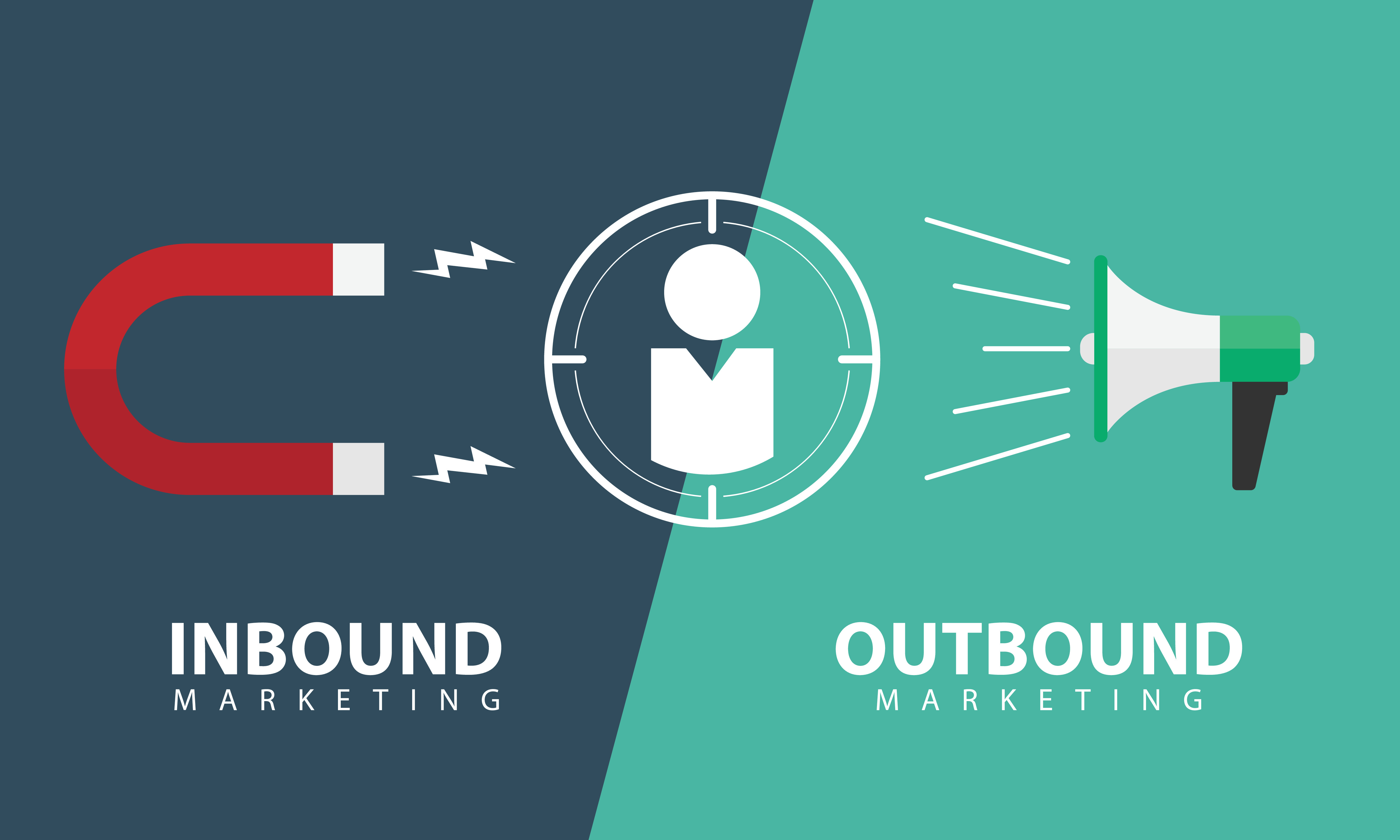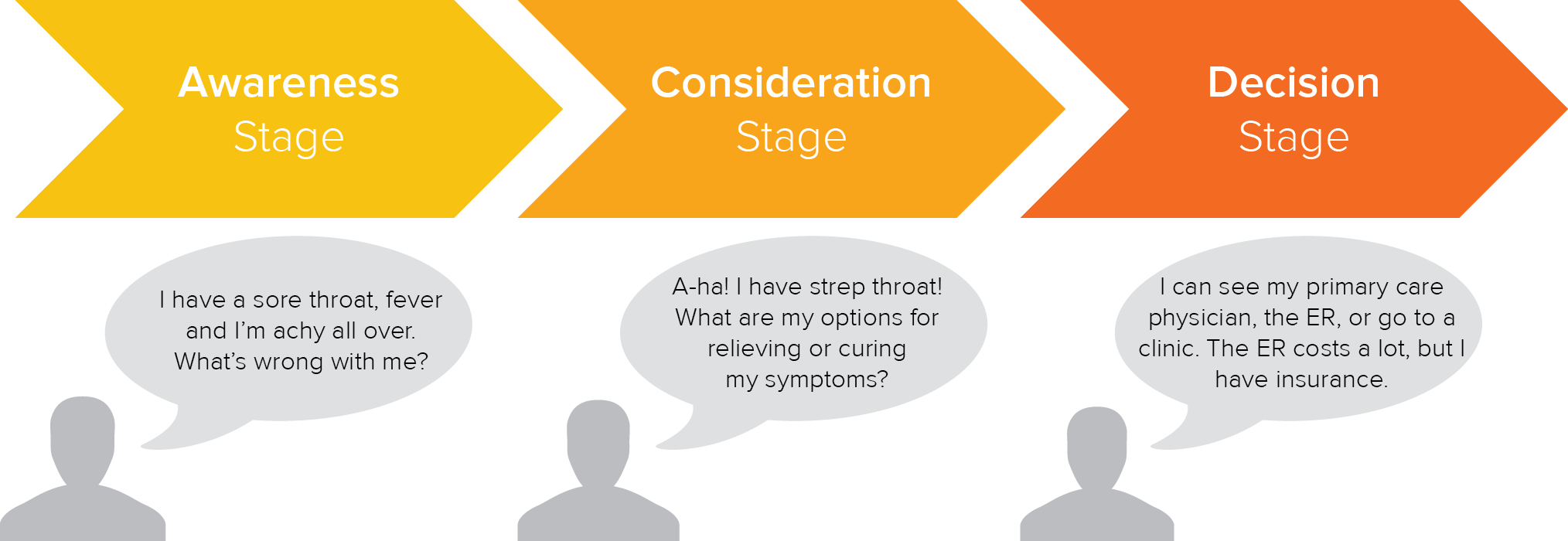
As a marketing professional, it’s your job to create great experiences for your prospects and customers, generate qualified leads for your sales team, and build and nurture a subscriber list of potential customers.

As digital marketing progresses at a faster and faster rate, you may be wondering not just how to keep up – but how to thrive. As part of that question, you may be wondering which marketing strategy is right for you – inbound marketing or outbound marketing.
Inbound Marketing vs Outbound Marketing
The old way of marketing just doesn’t work anymore. Think about telemarketing – when was the last time that you answered a strange call from a sales rep? How about direct mail? Does it ever not go in the trash? Billboards and newspaper ads? Still effective but getting more irrelevant all the time. In place of these old-school outbound channels, many marketing tactics have moved online, and they’re focused on creating value and providing high-quality information to your potential customers.
Traditional outbound marketing strategy is what you probably think of when you think of general marketing, like Mad Men. Outbound marketing techniques focus a lot on TV and radio advertising and often uses a “spray and pray” approach that can make it difficult to determine what’s working and what’s not.
What are traditional outbound marketing tactics?

When you think about traditional marketing strategies, your mind probably goes to things like cold calling, direct mail, billboards, tv or radio advertising, or print advertising (the Yellow Pages, anyone?). These outbound techniques were effective in the past for a few reasons:
- People had to rely more on salespeople for information. You couldn’t just Google products or services and compare reviews. You had to rely on the expertise of the people selling the product or service to educate you.
- There was less noise. I can’t turn around now without hearing an ad on Pandora, or seeing an ad on Hulu, or driving past a billboard, or scrolling past ads on social media or blogs that I follow. Because everyone now has access to inexpensive advertising, there’s a lot more of it – so your marketing has to be really good to stand out.
- They were the only techniques you had at the time. Sure, a marketing campaign was hard to place and harder to measure and optimize, but marketers had to do the best they could with what they had.
Can an outbound marketing approach be effective? Sure they can! Outbound tactics also tend to be interruptive, they can be hard to measure, and they’re often difficult to scale.
What is Inbound Marketing?

When most people ask the question, why inbound marketing vs outbound marketing, it’s normally because they’re trying to figure out if the opportunities created by Inbound Marketing are worth it. Let’s explain the main difference of an Inbound Marketing approach and how you can use it to grow your business. Inbound marketing exists because the way that people buy has changed. Consumers have access to all the information they could possibly want, and they are looking for a trusted advisor to help steer them in the right direction. As a result, Inbound marketing strategies tend to focus on being helpful, adding value to your customer’s journey, and helping your potential customers find answers to their problems. Inbound Marketing is part of a larger framework (The Inbound Marketing Methodology) that focuses on attracting the right people to your business, engaging with your prospects in meaningful ways, and delighting them so that they become advocates of your brand. Inbound marketing is more of a slow-burn approach, but your investment in Inbound Marketing can pay dividends over the long haul.
What are Inbound Marketing Tactics?

When we think about Inbound Marketing, we generally think about it in terms of that first goal: attracting the right audience to your business. I like to think about this Attraction stage as having 4 sub-stages: Creating Awareness, Adding Value, Generating Leads, and Lead Nurturing. If you think about your customer pipeline as a sales funnel, it’s the top half of the funnel – everything that takes place in between the time that a prospect first hears about your company to the time that you’re ready to hand that potential customer off to a member of your sales team.
Creating Awareness
This first stage has to do with getting your company in front of the right audience. This can be accomplished in a number of ways – starting with digital advertising. Digital ads can present some really powerful opportunities for you to get your message in front of the exact audience that is hungry to buy your product or service. You get a ton of data from digital ads, and you can run a lot of ads at the same time, so it’s easy to test different concepts to determine what works best. These digital ads are great because they’re meeting people where they already are: across all the social media platforms, in search engine result pages, and in banner ads on sites across the internet.
Another aspect of creating awareness is through Search Engine Optimization, or SEO. SEO involves ensuring that the content on your website, whether it’s your homepage or an article on your blog, are both providing value to your readers and providing context to search engines like Google so they can see what your page is about. Search Engines take the information on your page along with behavioral data, like how long people spend on your site, and what other sites are linking to yours, to determine what results should show up when someone Googles something. SEO is one part science and one part art, but should be 100% focused on providing value to your prospects.
Success in this stage is normally measured by how many people are coming to your website, how quickly your retargeting audience is growing, the number of keywords that you’re ranking for organically, and the performance of your digital advertising channels.
Adding Value
The second sub-step of the Inbound Marketing Attract stage is adding value to the audience that just discovered you. As Ryan Deiss from Digital Marketer says, you want “to turn a glance into a stare.” You do this through really good blog and social media content, and you get back in front of these potential customers using retargeting ads, served through social media platforms or over the Google Display network.

This sub-stage is largely synonymous with Content Marketing, and the content that you will create to add value is a little different than your Awareness content. As you write this engaging content, you are primarily focused on helping your audience understand their problems.
Success in this stage is usually measured by how many blog views you are receiving, how many repeat visitors are coming to your website, and how many people are engaging with your social media content.
Lead Generation
One of the main goals of Inbound Marketing is lead generation. At its core, lead generation is about getting your ideal prospects to subscribe to something. In other words, you’re trading a valuable piece of content or expertise for their email address and permission to contact them. While in the past it may have been possible to have a form in your website’s footer saying “Subscribe to my Newsletter!”, it today’s world you have to be a little more strategic to be successful. Remember, everyone is over-loaded with information, most people are already subscribed to more newsletters than they can shake a stick at, and as a result your offer has to be really valuable.
{{cta(‘fdc8c07a-8304-45e2-97bd-6b548c0e9564′,’justifycenter’)}}
Here’s how the most successful businesses treat lead generation. First, they’ll do a deep dive on their customer to uncover their some of their biggest pain points. Then, they’ll create an offer that has a low barrier of entry. For eCommerce sites, this offer might be as simple as a coupon on a customer’s first purchase. For B2B companies, it might be an ebook, or an invitation to a webinar.
Most of the time, your offers will get their very own landing pages so that you can link to them from social media, or your blog, or directly from your ads. Success is generally measured by how many people are viewing your landing pages and, of those people, what percentage of them are converting into leads.
Lead Nurturing
The final stage of our Inbound Marketing plan is lead nurturing, primarily through email marketing and marketing automation. It’s not enough just to get somebody’s email address, you also want to ensure that they’re a good fit for your business. Lead nurturing generally involves feeding your prospects a stream of content that provides value and pulls your leads deeper into your sales funnel. During this phase, you want for the prospect to spend time with your brand, receive a lot of value from you, and really begin to see and articulate the need for your products and services.
By the end of this stage, you really want to “convert” the prospect into a qualified lead. Generally, when we think about “conversion”, what we mean is that they either spend a little bit of time or a little bit of money with you.
For an eCommerce site, it could be that someone signing up to receive a discount fulfills the Lead Generation phase, but when they use the coupon to place their first order (spending a little bit of money) it completes the Lead Nurturing phase. For B2B companies, it might be that when someone signs up for a webinar, it completes the Lead Generation phase, but when they actually attend the webinar (spending a little bit of time), it completes the Lead Nurturing phase.
At the end of this phase, you want to have a prospect or new customer who is committed and excited about your brand. Depending on your business model, this is where a lot of your traditional inbound marketing activities come to an end, and your inbound sales activities really kick into high gear.
Inbound vs Outbound Marketing: Which is best?
Businesses use inbound and outbound marketing are different approaches to marketing, and they both accomplish different purposes. Outbound marketing is still very popular and it can be effective in selling your products and services if you use it correctly and focus on helping your prospects. Outbound typically works better for businesses with lots of salespeople and smaller opportunity pipelines, while inbound can work for just about any company.
They’re also not mutually exclusive, meaning that you can do both marketing strategies at the same time. Inbound Marketing typically does require a good strategy and the right technology to automatically lead people through the sales funnel. Inbound is also more of a long-term strategy, so it may take 6 months or more to start seeing results. There’s also a pretty large upfront cost in content creation that has to happen if you’re going to be successful. So if you’re only doing traditional marketing, we’d encourage you to really give some thought to whether you should dabble in inbound.
Inbound Marketing Results
Inbound marketing works. According to HubSpot, one of the largest (and in our opinion best) inbound marketing tools on the market, the average company sees 2.1x more website visitors per month within one year, 2.5x more leads per month within one year, and 70% of of companies saw an increase in the conversion rate from lead to customer. If those types of numbers get you excited, then inbound marketing is probably for you.
{{cta(‘bd2ab1d5-e192-4924-bf48-3611280fc51e’)}}
How to Get Started with Inbound
DIY Options
If you want to execute Inbound Marketing yourself, there are a few resources that I would recommend. First of all, you need some good training and you need the right software. For training, I recommend Digital Marketer – they have a Digital Marketing Certification that is absolutely amazing. In fact, when we became Certified Partners with Digital Marketer, we changed the way that we plan and execute on strategies for our clients because they’re so revolutionary in how they think. So, check them out – take the Digital Marketer Certification, and sign up for their Lab, which gives you lots of playbooks and techniques that you can swipe, tweak, and use right out of the gate.
After you get some training from Digital Marketer and get ready to start running an inbound campaign, I would encourage you to sign up for HubSpot. They have tiers for everyone – they even have a free tier if you’re wanting to start slow and grow with them – you can build landing pages, create popup forms, and even do some email marketing. Even if you’re running an inbound strategy yourself, I would recommend for you to work with an agency to get HubSpot set up properly. A little bit of work on the front end will go a long way.
Working with an Inbound Agency
If you love the idea of Inbound Marketing, but know that you don’t have the time or brain capacity to learn a bunch of new marketing tactics, then hire an agency to help you. While many people think that hiring an agency is expensive (and don’t get me wrong – it can be!), you can usually find an Inbound Marketing Agency that runs about the cost of one entry-level employee. That means that instead of hiring a Marketing Assistant out of college who is using your business as a guinea pig, you get access to a team of experts who have done this 100 times. It can be a very good way to go, and the ROI can be very well worth it.
{{cta(‘1be0fccf-4a7a-458a-a15a-ffaf09f80d73’)}}
Ready to take your business to the next level?
{{cta(’33a1ada3-a137-4020-a769-a8c36e667cc7′,’justifycenter’)}}





